The annual ritual of getting ready to go back to school is a transitional time to focus students and their families on formal learning for the rest of the academic year. Starting school is often filled with dread for young scholars, but scaffolding summer memories into learning moments during the first days of school could be a great way to enter the new period of learning and growing. This week the members of the Children’s Literature SIG present books encompassing diverse life experiences for students of all ages. Some of these experiences are familiar, but many are novel and enriching, encouraging more learning moments for the students as they return to school.
Grades K-2
Brown, Peter. (2014). My Teacher Is a Monster! (No, I Am Not.). New York, NY: Little, Brown and Company.
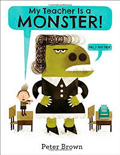 Many children fear the first day of school with separation anxiety or the fear of strangers, including new teachers. Robert thinks his teacher, Ms. Kirby, is a monster because in her classroom she yells and is strict. Robert likes to go to the park during his free time to relax, but to his surprise he meets Ms. Kirby there. When he does a favor for her, it breaks the awkwardness between the two and they share their favorite parts of the park with one another. The illustrations show that Ms. Kirby changes with Robert’s mood and feelings about her.
Many children fear the first day of school with separation anxiety or the fear of strangers, including new teachers. Robert thinks his teacher, Ms. Kirby, is a monster because in her classroom she yells and is strict. Robert likes to go to the park during his free time to relax, but to his surprise he meets Ms. Kirby there. When he does a favor for her, it breaks the awkwardness between the two and they share their favorite parts of the park with one another. The illustrations show that Ms. Kirby changes with Robert’s mood and feelings about her.
—Ying-Hsuan Lee, Washington State University Pullman
Fern, Tracey. (2014). Dare the Wind: The Record-Breaking Voyage of Eleanor Prentiss and the Flying Cloud. Illus. by Emily Arnold McCully. New York, NY: Margaret Ferguson Books (Farrar Straus Giroux Books).
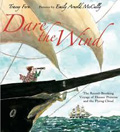 Many students returning to school might have just visited the beach or seen the sea for the first time. This story of Ellen Prentiss is a perfect way to scaffold those experiences into lessons on American history and the oceans. Young Ellen loved the seas. Her father recognized this and taught her how to sail his schooner across the Massachusetts Bay. She learned how to handle the instruments, and her skills were so great that she married a sailor and together they sailed an extreme clipper, Flying Cloud, to bring passengers from New York to San Francisco and from Cape Horn to California during The Gold Rush. The journey of 15,000 miles was completed in 89 days. The feat was accomplished using wind and ocean power alone. Readers are treated to drama on the high seas and Ellen’s courage. An author’s note provides more background information on Ellen and sailing. Teachers may want to visit the excellent author website and read the illustrator interview.
Many students returning to school might have just visited the beach or seen the sea for the first time. This story of Ellen Prentiss is a perfect way to scaffold those experiences into lessons on American history and the oceans. Young Ellen loved the seas. Her father recognized this and taught her how to sail his schooner across the Massachusetts Bay. She learned how to handle the instruments, and her skills were so great that she married a sailor and together they sailed an extreme clipper, Flying Cloud, to bring passengers from New York to San Francisco and from Cape Horn to California during The Gold Rush. The journey of 15,000 miles was completed in 89 days. The feat was accomplished using wind and ocean power alone. Readers are treated to drama on the high seas and Ellen’s courage. An author’s note provides more background information on Ellen and sailing. Teachers may want to visit the excellent author website and read the illustrator interview.
—Rani Iyer, Washington State University Pullman
Gaiman, Neil. (2014). Chu’s First Day of School. Illus. by Adam Rex. New York, NY: HarperCollins Publishers.
 A young panda, Chu, is worried about his first day of school even though his parents comfort him. Chu’s worries are still there when he goes to school and meets his classmates. In his first class, his friendly teacher has all the students introduce themselves with their names and one of their habits. Jengo, a giraffe, likes to reach things in high places, Pablo, a monkey, likes to climb up something, Robin, a robin, likes to sing, Tiny, a snail, likes to stay in his room. When it is Chu’s turn, Chu gives a huge sneeze that blows away everything in the classroom including the desks, chairs, classmates, and the teacher, as a way to introduce himself. Such improvisation makes Chu feel safe and dispels his worries. Told in a relaxing and funny way, this story portrays many young readers’ worries on their first day of school. With vivid and vibrant illustrations, this book may help young readers laugh instead of worry about the first day of school.
A young panda, Chu, is worried about his first day of school even though his parents comfort him. Chu’s worries are still there when he goes to school and meets his classmates. In his first class, his friendly teacher has all the students introduce themselves with their names and one of their habits. Jengo, a giraffe, likes to reach things in high places, Pablo, a monkey, likes to climb up something, Robin, a robin, likes to sing, Tiny, a snail, likes to stay in his room. When it is Chu’s turn, Chu gives a huge sneeze that blows away everything in the classroom including the desks, chairs, classmates, and the teacher, as a way to introduce himself. Such improvisation makes Chu feel safe and dispels his worries. Told in a relaxing and funny way, this story portrays many young readers’ worries on their first day of school. With vivid and vibrant illustrations, this book may help young readers laugh instead of worry about the first day of school.
—Ying-Hsuan Lee, Washington State University Pullman
Kenfack, Gladys. (2014). Mambo Goes to School. Illus. by Hertzy Vital Ole Tsimi. CreateSpace Independent Publishing Platform.
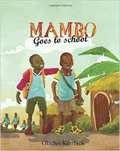 In a small village of Cameroon lives a young boy, Mambo, who is excited about his first day to school. After taking a bath in the river, having homemade donuts and porridge as breakfast, and packing bananas as the snack, Mambo goes to school with his friend. The school day starts with a flag-raising ceremony while all the students sing the national anthem. Then students head to their assigned classrooms to meet with their new classmates and teachers. On this very first day of school, Mambo learns about all the body parts along with a song, which piques his interests in learning. Of course, playing with other children during the break and sharing snacks with friends are the part of the school day that Mambo enjoys the most. With so many interesting events happening on the first day of school, Mambo goes home with his heart contented. This is a special book to invite children to see what the first-day-of-school experience looks like for students from other cultures. From the school routine to Mambo’s way to address teachers and other classmates, teachers can use this book to engage students in a discussion about cultural differences in school experiences.
In a small village of Cameroon lives a young boy, Mambo, who is excited about his first day to school. After taking a bath in the river, having homemade donuts and porridge as breakfast, and packing bananas as the snack, Mambo goes to school with his friend. The school day starts with a flag-raising ceremony while all the students sing the national anthem. Then students head to their assigned classrooms to meet with their new classmates and teachers. On this very first day of school, Mambo learns about all the body parts along with a song, which piques his interests in learning. Of course, playing with other children during the break and sharing snacks with friends are the part of the school day that Mambo enjoys the most. With so many interesting events happening on the first day of school, Mambo goes home with his heart contented. This is a special book to invite children to see what the first-day-of-school experience looks like for students from other cultures. From the school routine to Mambo’s way to address teachers and other classmates, teachers can use this book to engage students in a discussion about cultural differences in school experiences.
—Ying-Hsuan Lee, Washington State University Pullman
Myracle, Lauren. (2014). The Life of Ty: Non-Random Acts of Kindness. New York, NY: Dutton Children’s Books.
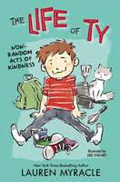 When students return to school, it is not always clear to them that they have to face higher expectations and that life can get a tad busy trying to keep up with new work. Ty has just entered second grade, and his brain is filled with many thoughts. On the homefront his pre-occupation is to find a pet for his baby sister Maggie (he secretly hopes she will like the monkey he has selected), and at school he is busy hatching schemes to avoid the dreaded neck-pinch-of-death. All these challenges pale when he has to present an act of kindness as indicated by Mrs. Webber, his teacher. Towards the end of the book, Ty is desperate to do his good deed, and he does so in a simple way.
When students return to school, it is not always clear to them that they have to face higher expectations and that life can get a tad busy trying to keep up with new work. Ty has just entered second grade, and his brain is filled with many thoughts. On the homefront his pre-occupation is to find a pet for his baby sister Maggie (he secretly hopes she will like the monkey he has selected), and at school he is busy hatching schemes to avoid the dreaded neck-pinch-of-death. All these challenges pale when he has to present an act of kindness as indicated by Mrs. Webber, his teacher. Towards the end of the book, Ty is desperate to do his good deed, and he does so in a simple way.
—Rani Iyer, Washington State University Pullman
Grades 3-5
Cheng, Andrea. (2014). The Year of the Fortune Cookie. Illus. by Partice Barton. New York, NY: Houghton Mifflin Harcourt.
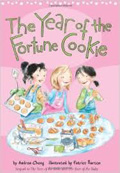 In this sequel to The Year of the Baby (2013), Anna has been waiting for eight months to hear about the status of adoption of a baby from China for her former teacher, Mrs. Sylvester. Anna hopes to visit the orphanage her sister was adopted from in China. Her friends hold a bake sale to collect money and knit hats for every child in the orphanage (about 50 in all) and, finally, while completing her assignments in China, Anna begins to examine what it means to be Chinese. In China, nobody stares at her or makes comments such as “ching-ching.” However, they speak to her in Chinese, and Anna finds it tiring to speak in Chinese all the time. Her vocabulary words are limited. Anna becomes friends with Fan, a young girl working in a restaurant, while waiting for the baby to be delivered to Mrs. Sylvester. Their trip is short, for just 12 days, and Baby Jing is finally delivered two days before they leave for United States. And Anna is thrilled to be permitted to visit the orphanage. The book has a useful list of Chinese words and is a welcome inclusion for bilingual students. As classrooms become more diverse, teachers might like to look for books that reflect cultural composition in the classroom and include them in lessons.
In this sequel to The Year of the Baby (2013), Anna has been waiting for eight months to hear about the status of adoption of a baby from China for her former teacher, Mrs. Sylvester. Anna hopes to visit the orphanage her sister was adopted from in China. Her friends hold a bake sale to collect money and knit hats for every child in the orphanage (about 50 in all) and, finally, while completing her assignments in China, Anna begins to examine what it means to be Chinese. In China, nobody stares at her or makes comments such as “ching-ching.” However, they speak to her in Chinese, and Anna finds it tiring to speak in Chinese all the time. Her vocabulary words are limited. Anna becomes friends with Fan, a young girl working in a restaurant, while waiting for the baby to be delivered to Mrs. Sylvester. Their trip is short, for just 12 days, and Baby Jing is finally delivered two days before they leave for United States. And Anna is thrilled to be permitted to visit the orphanage. The book has a useful list of Chinese words and is a welcome inclusion for bilingual students. As classrooms become more diverse, teachers might like to look for books that reflect cultural composition in the classroom and include them in lessons.
—Rani Iyer, Washington State University Pullman
Gutman, Dan. (2014). My Weird School Special: Back to School, Weird Kids Rule! Illus. by Jim Paillot. New York, NY: HarperCollins Publishers.
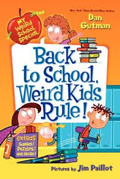 While Andrea is excited about going back to school, A.J. is quite reluctant to let summer vacation go. Being forced to come home early from their vacation in Bermuda due to a hurricane, A.J. and his family must stay in Andrea’s home for one week before school starts. To prepare for the new semester, the two complete their back-to-school shopping and purchase new clothes and stationary. As Andrea and A.J. are always fighting with each other and making noises during the shopping time and at home, their parents decide to send them to Camp Ockatollyquay. While Andrea and A.J. are dreaming about singing songs and playing sports in the camp, it turns out that Camp Ockatollyquay is to prepare children for school. Quick-witted Andrea knows how to turn tedious days at camp into an unforgettable summer experience. This short chapter book flavored with humor is quite entertaining for readers. Along with the amusing storyline are some highlights of what students usually do to get ready for school. Also, readers may identify with Andrea’s reasons for loving school.
While Andrea is excited about going back to school, A.J. is quite reluctant to let summer vacation go. Being forced to come home early from their vacation in Bermuda due to a hurricane, A.J. and his family must stay in Andrea’s home for one week before school starts. To prepare for the new semester, the two complete their back-to-school shopping and purchase new clothes and stationary. As Andrea and A.J. are always fighting with each other and making noises during the shopping time and at home, their parents decide to send them to Camp Ockatollyquay. While Andrea and A.J. are dreaming about singing songs and playing sports in the camp, it turns out that Camp Ockatollyquay is to prepare children for school. Quick-witted Andrea knows how to turn tedious days at camp into an unforgettable summer experience. This short chapter book flavored with humor is quite entertaining for readers. Along with the amusing storyline are some highlights of what students usually do to get ready for school. Also, readers may identify with Andrea’s reasons for loving school.
—Ying-Hsuan Lee, Washington State University Pullman
Grades 6-8
Carson, Mary Kay. (2014). Park Scientists: Gila Monsters, Geysers, and Grizzly Bears in America’s Own Backyard. Photos by Tom Uhlman. New York, NY: Houghton Mifflin Harcourt.
 Camping is a favorite activity of many Americans during breaks from school and national parks are favorite destinations for millions of visitors every year. But park visitors only get to see a small section of the forest. Vast areas are also visited by scientists who make scientific discoveries of the plants, animals, and geological marvels. Because of this, national parks are also called living laboratories. This book begins with a brief introduction to the natural laboratories and living museums. The first chapter introduces the wonders of water and heat, the second introduces Yellowstone’s biggest bears. The third chapter is about scientists tracking the Gila monsters and counting cacti at the Saguaro National Park. The study of salamanders and the fire flies in the Great Smoky Mountain National Park are also presented here. This book offers interviews, close-up views of scientists at work and provides a great number of facts and interesting information about the research scientists are undertaking in the national parks. If you are looking for an engaging book with accurate pictures to introduce scientific methodology, this book should not be missed. Teachers may want to visit the author page for more information about the other works by the author, or visit the photographer’s page for more information about his work with children’s books.
Camping is a favorite activity of many Americans during breaks from school and national parks are favorite destinations for millions of visitors every year. But park visitors only get to see a small section of the forest. Vast areas are also visited by scientists who make scientific discoveries of the plants, animals, and geological marvels. Because of this, national parks are also called living laboratories. This book begins with a brief introduction to the natural laboratories and living museums. The first chapter introduces the wonders of water and heat, the second introduces Yellowstone’s biggest bears. The third chapter is about scientists tracking the Gila monsters and counting cacti at the Saguaro National Park. The study of salamanders and the fire flies in the Great Smoky Mountain National Park are also presented here. This book offers interviews, close-up views of scientists at work and provides a great number of facts and interesting information about the research scientists are undertaking in the national parks. If you are looking for an engaging book with accurate pictures to introduce scientific methodology, this book should not be missed. Teachers may want to visit the author page for more information about the other works by the author, or visit the photographer’s page for more information about his work with children’s books.
—Rani Iyer, Washington State University Pullman
Nelson, Marilyn. (2014). How I Discovered Poetry. Illus. by Hadley Hooper. NewYork, NY: Dial Books.
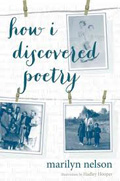 Some students may have discovered poetry during the summer vacation. They and other students will find several treasures in this wonderful collection of poems by Newberry Honor Winner, Marilyn Nelson. The 50 poems in this slim volume range from the earliest memories of the poet as a 4-year-old child giggling in the church to her 14th year during a tumultuous time when Civil Rights, feminism, and living in the shadow of missiles and the atomic bomb. The poems were written from various Air Force bases as the poet’s family traveled all over the country. In the poem “Career Girl,” she pays tribute to her mother and her unique ways, comparing her with other mothers by saying, “They don’t care about Making History.” She also makes note of her skin color with humor and courage when she says, people with dark skins have “…shine-in-the-dark white eyes and teeth…” Filled with gentle humor, this book is a great companion for students learning about the Civil Rights Movement, budding poets, or about racism and the lives of women during that time. Teachers can learn more about the author by visiting her wonderful website and the feature on American Academy of Poets. An interview of the poet regarding the book and her life is also available on NPR.
Some students may have discovered poetry during the summer vacation. They and other students will find several treasures in this wonderful collection of poems by Newberry Honor Winner, Marilyn Nelson. The 50 poems in this slim volume range from the earliest memories of the poet as a 4-year-old child giggling in the church to her 14th year during a tumultuous time when Civil Rights, feminism, and living in the shadow of missiles and the atomic bomb. The poems were written from various Air Force bases as the poet’s family traveled all over the country. In the poem “Career Girl,” she pays tribute to her mother and her unique ways, comparing her with other mothers by saying, “They don’t care about Making History.” She also makes note of her skin color with humor and courage when she says, people with dark skins have “…shine-in-the-dark white eyes and teeth…” Filled with gentle humor, this book is a great companion for students learning about the Civil Rights Movement, budding poets, or about racism and the lives of women during that time. Teachers can learn more about the author by visiting her wonderful website and the feature on American Academy of Poets. An interview of the poet regarding the book and her life is also available on NPR.
—Rani Iyer, Washington State University Pullman
Rubin, Susan Goldman. (2014). Everybody Paints: The Lives and Art of the Wyeth Family. San Francisco, CA: Chronicle Books.
 For students interested in art, and for teachers to connect art with history and real life, this book provides a wonderful opportunity. Featured in this single volume are the works and times of a family of artists of world renown who upheld art when the world was being conquered by photography, television and movies. The three generations of gifted painters-N.C., Andrew, and Jamie, form the ‘first family’ of American art. Beginning with the birth of N.C. Wyeth, the author takes the readers through the trials, times, and tribulations of their times and how it influenced their art. Stunning color reproductions of their art work enlivens the page and invites the readers to pause and examine the details of the art. Determined to show what American life was about, N.C. and Andrew painted until almost the very last day in their lives. To gain the best benefits from this book, students should be given time to read, reflect on the images in the book, and make personal connections. The Andrew Wyeth website is still active and provides pictures of numerous images and exhibits teachers can visit the author’s website for recent information regarding the book and related events. The National Art Gallery in Washington D.C. also houses some of the wonderful images.
For students interested in art, and for teachers to connect art with history and real life, this book provides a wonderful opportunity. Featured in this single volume are the works and times of a family of artists of world renown who upheld art when the world was being conquered by photography, television and movies. The three generations of gifted painters-N.C., Andrew, and Jamie, form the ‘first family’ of American art. Beginning with the birth of N.C. Wyeth, the author takes the readers through the trials, times, and tribulations of their times and how it influenced their art. Stunning color reproductions of their art work enlivens the page and invites the readers to pause and examine the details of the art. Determined to show what American life was about, N.C. and Andrew painted until almost the very last day in their lives. To gain the best benefits from this book, students should be given time to read, reflect on the images in the book, and make personal connections. The Andrew Wyeth website is still active and provides pictures of numerous images and exhibits teachers can visit the author’s website for recent information regarding the book and related events. The National Art Gallery in Washington D.C. also houses some of the wonderful images.
—Rani Iyer, Washington State University Pullman
Grades 9-12
Schroeder, Lisa. (2014). The Bridge From Me to You. New York, NY: Point.
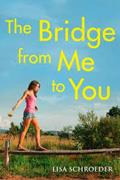 Lauren has a fight with her mother and is forced to move from Seattle to attend high school in a small town in Oregon, where she meets the town’s high school football star, Colby. Their first encounter at the local Jiffy Mart fosters a quick connection. However, their shared bonds over passions for birds and bridges are not enough to surmount the secrets both of them are guarding. After Colby’s friend is injured, the teens find ways to help each other deal with life’s challenges. The romance between them develops slowly as the story progresses.
Lauren has a fight with her mother and is forced to move from Seattle to attend high school in a small town in Oregon, where she meets the town’s high school football star, Colby. Their first encounter at the local Jiffy Mart fosters a quick connection. However, their shared bonds over passions for birds and bridges are not enough to surmount the secrets both of them are guarding. After Colby’s friend is injured, the teens find ways to help each other deal with life’s challenges. The romance between them develops slowly as the story progresses.
—Ying-Hsuan Lee, Washington State University,Pullman
These reviews are submitted by members of the International Reading Association's Children's Literature and Reading Special Interest Group (CL/R SIG) and are published weekly on Reading Today Online.